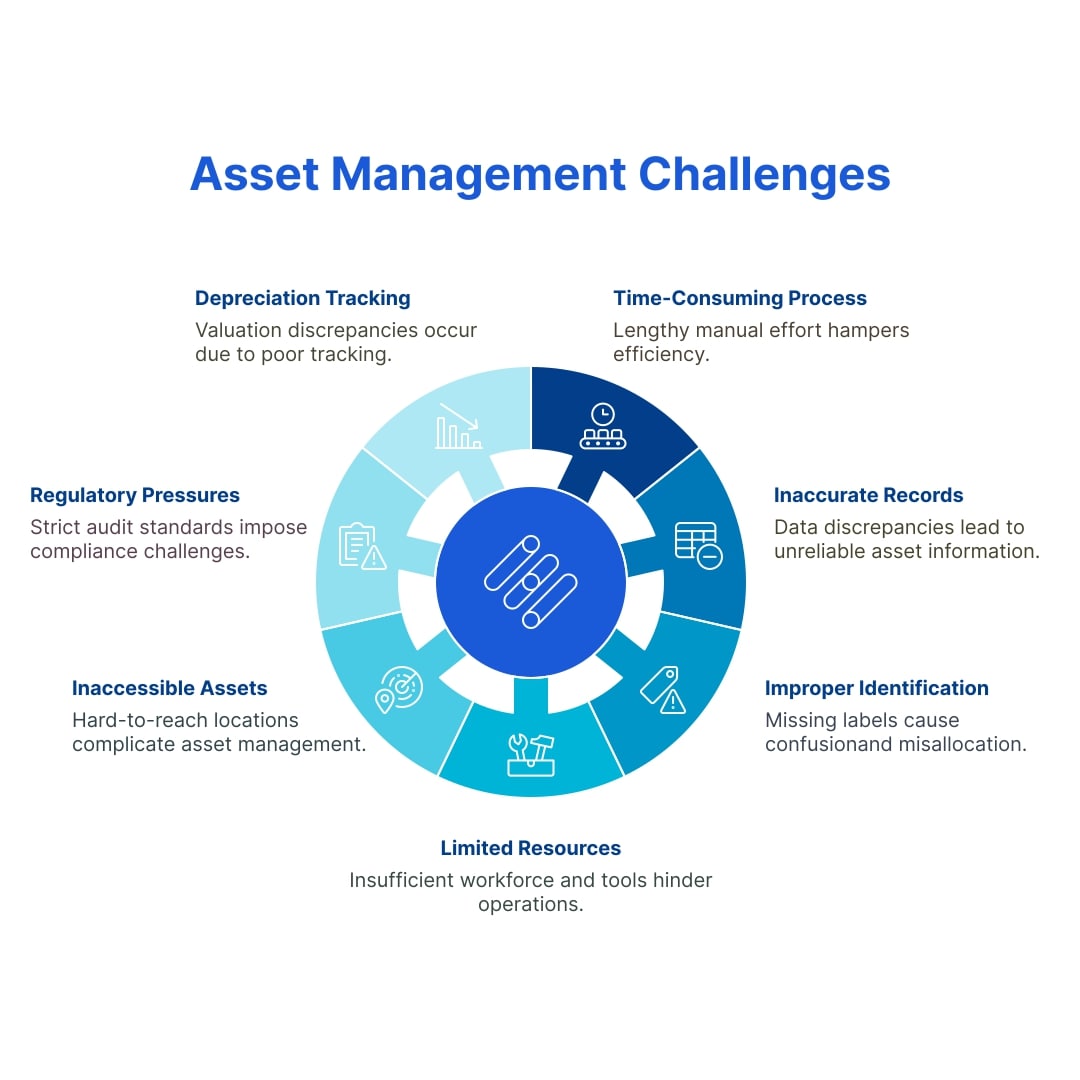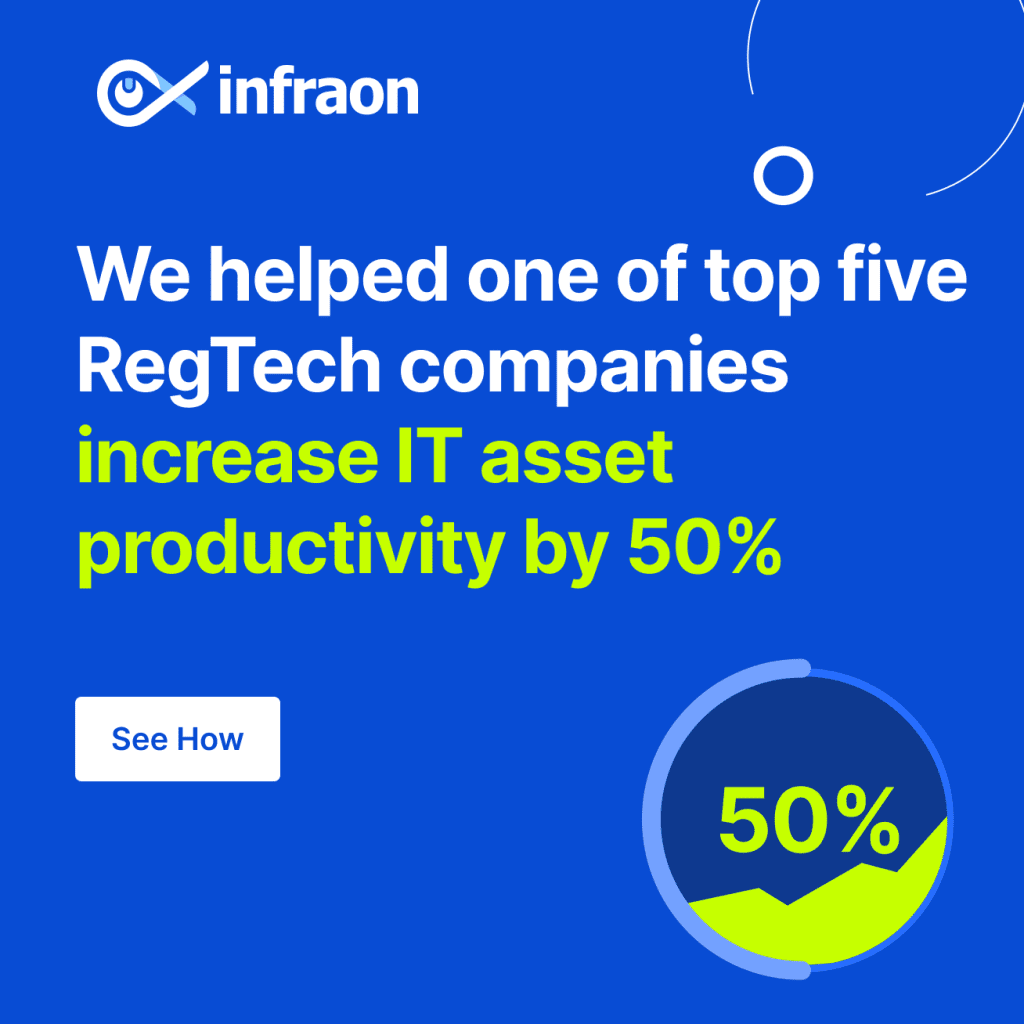Are you confident that all your fixed assets inventory is accounted for? What if hidden discrepancies are draining your business resources? Fixed asset verification ensures that your fixed assets, such as machinery, vehicles, and equipment, are properly managed and tracked. Effective fixed asset tracking system remains a significant challenge for many businesses.
This is where physical verification ensures your assets align with your records. Why is this so important? Accurate verification prevents costly errors and mismanagement and keeps your business audit-ready and compliant with regulations.
But here’s the challenge: physical verification isn’t as simple as it sounds. How do you tackle fixed asset tracking challenges like managing extensive inventories, dealing with outdated records, or keeping track of assets in hard-to-reach locations?
In this blog, we’ll examine the top challenges in the physical verification of fixed assets and explore innovative solutions to streamline this daunting task.
Related article: Best Practices in Infrastructure Asset Management
What is Physical Verification of Fixed Assets?
Physical verification refers to physically inspecting and cross-checking actual assets against their recorded data in a company’s asset register or management system. This procedure involves counting, identifying, and validating the assets’ presence, condition, and location to ensure they match the financial or asset management system data.
The process of Fixed Asset Physical Verification involves the following steps:
- Planning: The first step is to plan the physical verification process, which includes identifying the assets to be verified, setting the verification dates, and appointing a team to carry out the process.
- Preparing: The team responsible for the verification process must prepare a list of assets to be verified, along with their description, location, and quantity. The team should also prepare tags or labels to be attached to the assets to indicate that they have been verified.
- Physical Verification: Once the planning and preparation are complete, the team can begin the physical verification process. They must visit each location where the assets are located and verify their existence, condition, and quantity. The team must also check for any missing or damaged assets.
- Reconciliation: After completing the physical verification, the team must reconcile the results with the company’s fixed asset register. Any discrepancies must be investigated, and necessary adjustments made to the register.
- Reporting: Finally, the team must prepare a report on the physical verification process, including any discrepancies found, the corrective actions taken, and recommendations for future improvements.
The importance of Fixed Asset Physical Verification cannot be overstated. It ensures that the company’s financial statements accurately reflect the value of its fixed assets, which is essential for stakeholders such as investors, lenders, and regulators to make decisions. By verifying the existence and condition of fixed assets, companies can also prevent fraud, theft, and misuse of these assets.
Gain Total Visibility into Your Physical Asset Tracking 🔗
Common Challenges in Fixed Physical Verification
Fixed assets physical verification, also referred to as a fixed assets audit, involves a comprehensive review of a company’s long-term investments. This process entails verifying the existence, location, and condition of assets like buildings, land, machinery, and equipment not meant for sale in ordinary business. Physical verification is crucial to ensure that fixed assets are accurately reflected in financial statements and prevent misappropriation or theft. However, this process can present several challenges, such as:

- Time-Consuming Process: Verifying extensive inventories across multiple locations is a lengthy task that requires significant manual effort and resources, often leading to delays and inefficiencies.
- Inaccurate Asset Records: Discrepancies between physical assets and recorded data arise from outdated records, missed updates after asset transfers, or manual errors during asset entry.
- Improper Asset Identification: Assets without proper labels or tags (e.g., barcodes or RFID) make tracking and verifying their presence difficult, leading to confusion and potential errors.
- Limited Resources: Organizations may lack the necessary workforce or tools to perform thorough and efficient physical verification, especially when dealing with large or dispersed asset pools.
- Remote or Inaccessible Assets: Assets located in hard-to-reach or restricted areas pose logistical challenges for verification, making it difficult to ensure all assets are accounted for.
- Compliance and Regulatory Pressures: Failing to meet strict audit and compliance standards due to incomplete or inaccurate verification can lead to financial penalties or legal issues.
- Asset Depreciation and Condition Tracking: Tracking the condition and depreciation of assets during physical verification is a standard fixed asset accounting challenge, especially when records are not regularly updated or integrated with lifecycle management systems.

Implications of Inefficient Physical Verification in Fixed Asset Management
Inefficient physical verification can significantly impact your fixed asset tracking system and physical asset management software. This leads to a variety of operational, financial, and strategic challenges. Below are the key implications of inefficient physical verification:

- Financial Losses Due to Poor Asset Tracking: Inaccurate physical verification leads to missing or untracked assets in your fixed asset inventory management software. This results in unaccounted depreciation, financial discrepancies, and over/underinsured assets, leading to increased costs.
- Non-Compliance with Audit Requirements: A lack of proper physical verification can lead to inaccurate records, which can cause problems during a fixed asset audit. Non-compliance with audit and regulatory requirements may result in penalties, fines, and reputational damage.
- Poor Asset Utilization and Waste: Existing assets are overlooked or underused with inefficient verification. Physical asset tracking software can help streamline asset allocation, ensuring all resources are fully utilized. Fixed asset tracking challenges like misplacement or duplicate purchases occur when records are outdated.
- Increased Operational Downtime: Inaccurate asset data in physical asset management software delays locating critical assets, causing unexpected downtime. When assets are not adequately tracked, preventive maintenance schedules are affected, leading to unplanned failures.
- Risk of Theft or Mismanagement: Assets not verified during physical verification are more prone to theft or mismanagement, mainly when asset tracking is manual or inefficient. A fixed asset tracking system and physical asset tracking software can help ensure accountability and protect high-value assets from loss or misuse.
- Inefficient Decision-Making: The lack of accurate, real-time data from physical verification hampers strategic decisions regarding repairs, replacements, or disposals. When incomplete or inaccurate data is used, fixed asset accounting challenges emerge, affecting budgeting and forecasting efforts.
- Damaged Reputation and Trust: Discrepancies during a fixed asset audit or poor asset management can damage your company’s reputation, decreasing stakeholder trust. Failure to manage fixed asset tracking challenges efficiently signals operational inefficiency.
Inefficient physical verification processes lead to significant issues in asset tracking, financial management, and compliance. By utilizing a fixed asset tracking system, physical asset management software, and physical asset tracking software, companies can overcome fixed asset tracking challenges and ensure better-fixed asset accounting practices. Proper asset management minimizes risk, reduces costs, and improves decision-making processes, making it essential for operational efficiency.
Solutions to Overcome Fixed Physical Verification Challenges
Overcoming fixed asset verification challenges requires a strategic approach that combines technology, process improvements, and workforce training. Implementing fixed asset inventory best practices is key to ensuring accurate, efficient, and reliable asset management. Here’s how businesses can address these challenges effectively:
- Leverage Technology for Asset Tracking: Implement RFID and Barcode fixed asset inventory management tools to streamline asset identification and ensure accurate tracking. These tools enable efficient tagging and scanning of assets, reducing manual errors and simplifying the verification process.
- Automate and Regularly Update Records: Integrate fixed asset inventory management software with ERP or financial systems to automatically update records during asset transfers, acquisitions, or disposals. Regular updates reduce discrepancies and save time during physical verification.
- Conduct Periodic Audits and Spot Checks: Schedule regular fixed asset audits or spot checks to ensure asset data remains accurate and up-to-date. This helps catch discrepancies early and reduces the burden of extensive verification.
- Invest in Proper Staff Training: Ensure employees are trained in asset management best practices and tracking technologies. Proper training reduces human error and increases the efficiency of physical verification processes.
- Mobile Solutions for Remote Assets: Leveraging drones or mobile apps for hard-to-reach assets or remote locations. Mobile apps allow field staff to efficiently capture and verify asset data, even without access to a laptop or desktop.
- Outsource Verification When Needed: If in-house resources are limited, partner with third-party providers specializing in asset verification. Outsourcing can ensure accurate and timely verification without burdening internal staff.
- Implement IoT and Real-Time Tracking: Leverage Internet of Things (IoT) solutions for real-time tracking of high-value or critical assets. This enables automated monitoring and reduces the need for manual checks during physical verification.
- Improve Asset Condition Monitoring: Integrate condition-based monitoring tools to assess asset health and depreciation during verification. This ensures that assets are maintained optimally and accounted for in financial records.
By integrating these fixed asset inventory best practices, organizations can simplify their verification processes, improve accuracy, and ensure financial and regulatory requirements compliance.
Ready to streamline your fixed asset verification process? Explore how Infraon ITAM software can help you implement best practices and achieve seamless asset management. Contact us today!
Top 6 Tools and Technologies for Efficient Physical Verification
- Barcode Scanners and RFID Technology: Barcode scanners ensure quick, accurate asset identification. RFID tags enable real-time tracking and long-range asset monitoring.
- IoT (Internet of Things) Devices: IoT sensors provide real-time data on asset location, movement, and environmental conditions.
- Asset Management Software: Platforms like Infraon Asset Management streamline tracking, auditing, and inventory reconciliation.
- Mobile and Cloud Solutions: Mobile apps simplify on-the-go scanning, while cloud platforms centralize data access for distributed teams.
- AI and Machine Learning: AI improves accuracy by detecting data anomalies, streamlining verification, and enabling predictive maintenance.
- Blockchain Technology: Ensures secure, tamper-proof records of physical verification activities for compliance and audits.
These technologies optimize physical verification by enhancing speed, accuracy, and data reliability.
Benefits of Fixed Asset Verification Software
Fixed asset verification software can bring several benefits to businesses and organizations, including:
- Enhanced Accuracy and Reliability: Fixed physical asset tracking software eliminates human errors by automating asset tracking and reconciliation. This ensures that recorded data matches the actual physical assets, reducing discrepancies and improving the reliability of asset records.
- Time and Cost Savings: Automating the verification process significantly reduces the time required for physical fixed asset audits. It also prevents financial losses by identifying missing, unused, or misplaced assets, ultimately optimizing resource utilization and saving costs.
- Real-Time Asset Visibility: Gain real-time insights into asset locations, conditions, and movements across multiple sites. This feature is particularly beneficial for organizations with geographically dispersed assets or those dealing with frequent transfers.
- Improved Compliance and Audit Readiness: The software ensures compliance with regulatory and accounting standards by maintaining up-to-date and accurate records. It simplifies audit processes by generating comprehensive reports, reducing the risk of penalties due to non-compliance.
- Scalable and Customizable Solutions: The software can scale to meet your needs whether you’re managing hundreds or thousands of assets. Customization options allow businesses to adapt the tool to industry-specific requirements, ensuring maximum efficiency.
- Integration with Asset Management Systems: Seamlessly integrates with ERP, financial, and other asset management platforms, providing a unified view of your assets. This enables better decision-making and simplifies asset lifecycle management.
- Fraud Prevention and Asset Security: The software enhances transparency by providing a clear asset ownership, usage, and location trail. It helps detect discrepancies early, preventing asset misappropriation or theft and ensuring better control over high-value items.
Fixed asset verification software can significantly benefit businesses, including increased accuracy, time savings, compliance, cost savings, and better decision-making capabilities.
Maximize Efficiency with our Infraon Assets. Invest in innovative features to streamline asset management, reduce risks, and drive operational excellence.

Related article: Top Problems Due to Poor Asset
Final Note
Accurate financial reporting and efficient asset tracking start with the physical verification of fixed assets, but challenges like outdated records, poor labeling, and human errors can hinder the process.
Modern solutions, such as RFID tagging, asset-tracking software, robust record-keeping, and regular staff training, can simplify verification and enhance accuracy.
Overcoming these challenges streamlines the process and strengthens asset management strategies and financial reporting. Are you ready to elevate your approach? Visit our Infraon ITAM to get started!
FAQ
How do you conduct physical verification of fixed assets?
a) Prepare a Plan: Set objectives, define timelines, and assign roles for accountability.
b) Compile an Asset Register: Gather asset data and ensure it includes key details like ID, location, and condition.
c) Tag and Label Assets: Use barcodes, QR codes, or RFID tags to ensure accurate asset identification.
d) Conduct Physical Verification: Cross-check each asset with the register and verify location, condition, and status.
e) Update Records in Real Time: Use asset management software to record changes immediately.
f) Analyze and Reconcile Discrepancies: Investigate mismatches and update or recover missing items.
g) Generate Reports: Summarize the verification results, discrepancies, and corrective actions taken.
h) Implement Regular Verifications: Schedule periodic checks to maintain accuracy and compliance.
In which industries is asset verification critical?
a) Manufacturing: Physical verification is crucial to track large equipment, machinery, and tool volumes. It ensures efficient operations and prevents costly production delays due to untracked or misplaced assets.
b) Healthcare: Healthcare industries must regularly verify medical equipment to ensure availability and safety. This helps maintain compliance with regulatory standards and ensures that essential equipment is always ready for patient care.
c) Information Technology (IT): IT companies manage valuable assets like servers, computers, and software licenses. Regular physical verification ensures these assets are secure, up-to-date, and properly maintained, preventing potential resource loss or security risks.
d) Construction: Construction companies must track heavy machinery, tools, and materials across job sites. Physical verification helps ensure that high-value equipment is accurately tracked, reducing theft and maintenance costs while preventing project delays.
e) Retail: Physical verification helps monitor inventory and store equipment, such as point-of-sale systems. It prevents inventory shrinkage, supports supply chain management, and ensures that operational assets are correctly maintained for smooth store functions.




















